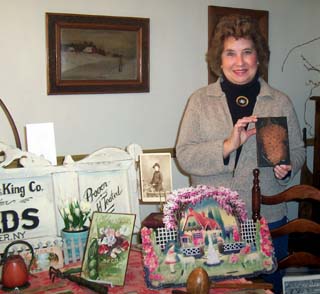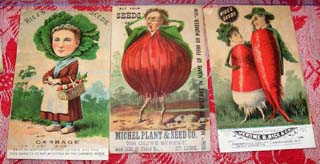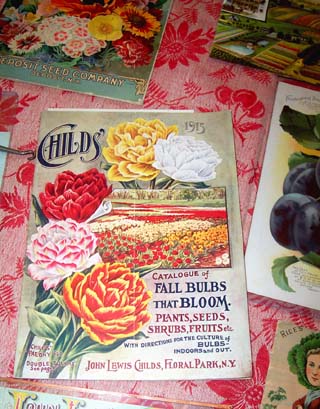
While Western New York may have recently savored a bit of spring time weather, Mary Isselhard can imagine spring and blooming flowers every time she looks at her collection of antique seed catalogs, seed packets and other collectibles. "I started collecting bits of floral items prior to my mother's death in 1990," Isselhard, of Clarendon, said. "I always loved the graphics and details that went into the old fashioned seed catalogs and packets." Following her mother's passing, Isselhard decided to recreate a garden her mother cultivated while Mary was growing up. "I wanted to put a garden together as a memorial to my mother because she always had such a wonderful garden," she said. What began as a slight interest bloomed into a full fledged collection which Isselhard now takes around with her on speaking engagements to various garden clubs and women's groups. "The golden era of graphics for the seed catalogs was from about 1880 to 1915," she said. "After that time, there was a more photographic - as opposed to hand drawn - representation of the contents of the packets." In addition to admiring the detail put into the crafting of the seed packets, Isselhard said the women who penned the drawings are a piece of missing history for the area. "None of the packets were signed and unless someone knows of a great-grandmother or relative who drew them, it could be a lost part of our history," she said. While she finds many of the parts of her seed packet collection on-line, Isselhard said she has had moments where "random events came together" and she stumbled upon treasures to add to her collection. "I was at an antique shop in Medina and they had a barrel of printer's blocks. I started digging through and found several copper-over-lead blocks with floral or fruit designs on them," she said. "It took me a couple of trips to get to the bottom of the barrel." Also during that trip she found printer's blocks that depicted the Clarendon Cook Wagon - a patented combination wagon that was built in the Clarendon area in the early 1900s. Isselhard's collection includes catalogs from John Lewis Church, who founded Floral Park in New York City. "The testimonials he had on his catalogs about his seeds were amazing - from aristocracy to the (backyard) gardener, they loved Church's seeds," Isselhard said. "Church also, for his convenience, founded the Floral Park Post Office which was the post office with the highest shipping volume by 1910." Charles Green, of Green's Nursery in Rochester, was known for his "inspirational" catalogs. "He was a wealthy gentleman who survived the crash of 1873 but had to start over from scratch. He bought 120 acres, rented out 100 and went on to develop his nursery and catalog," she said. "Green encouraged people who were down on their luck to turn to nature." Green's catalogs were zoned by locality and his seeds were guaranteed to produce, according to the geographical area they were planted. Vick's, of Rochester, printed the first color catalog and Isselhard said his trade was geared more toward the florals. The American Garden Club was the offshoot of area gardeners getting together and purchasing seeds in bulk in order to get a lower rate. "I think it's important for people to know the history of items, where they came from and how they came to be," Isselhard said of her collection and of the talks she gives surrounding it. "I've found a niche that has opened up a new world and helped enhance my love of gardening." Next on her agenda is researching memorabilia surrounding World War I Victory Gardens. When asked why she would pack her car full of collectibles and take them out for display, Isselhard said, "A collection means nothing unless you can share the beauty of it with others." March 19, 2006 |


